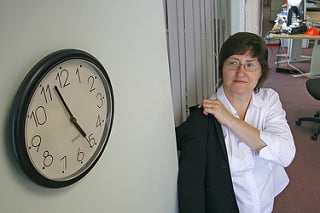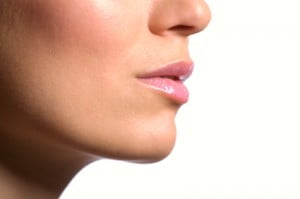 Surgery, fillers, or topical options?
Surgery, fillers, or topical options?
Laugh lines are among the most prominent, and least loved, signs of aging – it’s only a small comfort that they’re supposed to mean you’ve had a happy life so far. Nasolabial wrinkles, also known as “laugh” or “smile” lines, are the lines that seem to connect the edges of your lips to the edges of your nose. Some people take pride in their laugh lines, but plenty more would see them vanish.
If you’re one of the latter, you might be asking: what’s the best way to accomplish that?
It basically comes down to three options: surgical, injectables, and external skin care. Surgical options, such as facelifts or facial implants, are the longest-lasting but also the most expensive. Plus, being surgical procedures, there’s an element of risk involved. Injectable options like Botox and wrinkle fillers like Juvederm are less risky, but also more temporary, and will still cost a pretty penny. For the more frugal, there’s creams with retinol, like Retin-A. Retinoids are effective in preventing collagen loss, a chief culprit in the formation of laugh lines.
With all of these options, what’s the best choice? When it comes to the maximization of results-per-cost, and the minimization of risk, the injectable option comes out on top. Juvederm won’t last as long as a surgical option, but it can last upwards of 12 months before it needs topping off – at around $450 per cheek, that could work out to just $900 per year to keep laugh lines at bay. Basically, the injectable option yields the best results at the best price, with minimal risk to you.
However, only you can truly know what’s right for you, be it surgery, injectables, topical treatments, or even just letting yourself age naturally. Well, you and your surgeon – book a consultation and see what they think about your options. Hopefully, you’ll leave their office smiling.
 One of the benefits to Botox is how little time is needed to complete the procedure
One of the benefits to Botox is how little time is needed to complete the procedure
The world’s a busy place these days – there’s always somewhere to be, or someone to meet, or something to do. For busy folks who might want a little work done, the matter of recovery time might cause a problem.
Many aesthetic surgical procedures, such as facelifts, require a fair bit of down time in order for the body to heal properly, and it might be difficult for some people to set aside enough time to recover. But if you still want to say goodbye to wrinkles without using up your vacation time, you have options.
That’s one of the benefits of Botox – practically no recovery time. Also, unlike more invasive surgical procedures, Botox and other injectables like soft tissue fillers don’t require a number of hours on an operating table. Many of these procedures could be done on a lunch break – though, just to be on the safe side, it might be good too book at least a half day off work to let you go home and rest afterwards.
That said, Botox can’t permanently rid you of your wrinkles. However, Botox does last for several months, and while it can’t totally get rid of the wrinkles you have, it can help prevent new ones from forming. If you think you might be interested, the least you can do is spare a lunch hour to set aside time for a consultation with your cosmetic surgeon.
- Photo Credit: Time to go home by Alan Cleaver, on Flickr
 Are both wrinkle-removers made equal?
Are both wrinkle-removers made equal?
If you’ve followed the careers and lifestyles of Hollywood starlets like Marlene Dietrich, Raquel Welch, or Joan Crawford, you might be familiar with “Frownies” – adhesive strips meant to pull back wrinkles on the face, leading to a more youthful look. Actresses like these and more used them in the golden days of Hollywood, and they’re still around today. But, could Frownies be an alternative to Botox?
New York Magazine columnist Gina Grey recently put Frownies – or more accurately, a more modern alternative, Furlesse – to the test, with herself as the guinea pig. She wore the Furlesse patches for a week as she slept, to see if they could reduce or even prevent visible wrinkles.
She found that the strips did visibly diminish the appearance of facial wrinkles – so long as she was wearing them. Once removed, her wrinkles reappeared. According to a New York dermatologist quoted in the piece, the patches could potentially prove useful in stemming wrinkles by preventing involuntary facial movements while we sleep, but would take a lot longer than a week to show results.
And since the effects are only noticeable while the strips are worn, it means they won’t do you much good beyond the pillow – unless you’re willing to wear them out on the town. Actresses like Dietrich and Crawford did wear the strips in real life, hidden beneath wigs, but Way says, “unless he’s lost his sense of sight and touch, or is completely clueless, any guy will notice that you have these on.”
If you’re looking for more long-term results that are noticeable in your everyday life, and the idea of wearing adhesive strips 24/7 doesn’t appeal to you, there’s no contest – Botox wins out. Though, as with any cosmetic procedure, it shouldn’t be entered into lightly. Book a consultation with your surgeon before you decide.
 FDA advises consumers on spotting the difference
FDA advises consumers on spotting the difference
One of the things that makes Botox so popular with patients is how quick the procedure can be to undergo, and to recover from, compared to more invasive alternatives. But Botox is not quick or easy to produce, no – the product is made according to rigorous specifications and undergoes stringent quality control before it ever reaches the consumer.
Well, the official product, anyway.
The Food and Drug Administration has issued a warning to be on the lookout for counterfeit Botox. “FDA cannot confirm that the manufacture, quality, storage, and handling of these products follow U.S. standards,” said the agency, according to this Reuters article.
The product, which the FDA says is being sold under the names “Online Botox Pharmacy,” “Onlinebotox.com” and “Onlinebotox,” is being shipped from foreign sources, and is not approved for sale in the United States. Despite the name, most of these products are being solicited via fax.
Allergan, the makers of Botox, said that besides breaking federal law, the fraudulent Botox’s contents and the conditions of its storage and handling can’t be vouched for, making it potentially ineffective, or worse, unsafe.
Lawmakers are hard at work writing bills that would better track and oversee what prescription drugs are moving through the distribution chain. In the meantime, if you’re interested in Botox, but are wary of counterfeit product, feel free to bring up your concerns with your cosmetic surgeon during your consultation. As a patient, it’s your right and your duty to be as informed as possible before undergoing any procedure. A long-practiced and trustworthy surgeon will be happy to put your fears to rest and make you feel comfortable with the product they make available.
 Just what are marionette lines, anyway?
Just what are marionette lines, anyway?
When it comes to signs of aging, the lines that form around the mouth and nose are among the most dreaded. There are actually many types of facial wrinkles, all with different names and causes. One such variety is called marionette lines.
Marionette lines are the creases that form at the corners of your lips and extend down to the chin, which make the mouth appear droopy and gives the face an overall more grim or scornful appearance. Marionette Lines occur with the gradual loss of collagen and the decrease of fatty deposits in the mouth region. Some people never develop them, but others are genetically predisposed to them. Environmental conditions such as sun over exposure, poor diet, and smoking can also have an impact.
Since one of the causes of marionette lines is depleted fat deposits, one of the better ways of treating them is filling that space up, with a dermal filler like Juvederm. By filling that empty space under the skin, the appearance of marionette lines and other facial wrinkles can be minimized, if not outright erased.
If you’re worried about the onset of marionette lines, steps you can take ahead of time to avoid them include proper sunlight protection, getting lots of vitamins, exercise, and smoke avoidance. If, however, your smile falls victim to the onset of time, and marionette lines still occur, contact your cosmetic surgeon and book a consultation to see if Juvederm or another dermal filler is the right treatment for you.
Italian study says the two procedures go hand-in-hand.
Sometimes, a patient’s desired results from cosmetic surgery can’t be achieved with a single procedure.
It’s not uncommon for cosmetic surgeons to recommend undergoing two procedures simultaneously, and not just to pad the bill. In fact, combining procedures can save you money as well as time in recovery, and most importantly, can pay dividends when it comes to the aesthetic results of your time in the OR.
A study from the University of Verona in Italy has demonstrated the efficacy of combining rhinoplasty (a nose job) with genioplasty (chin augmentation). Researchers followed 90 patients who had both surgeries simultaneously between 2002 and 2004, and followed up with each of them over the next three years. The results showed that 45.6 per cent of those who had chin reduction surgery had no subsequent changes in the new chin, and 52 per cent of those with chin implants showed a stable profile in the following years.
The reason researchers believe these two surgeries go well together is because the proportions of the nose, chin, and neck are all tied together; if you correct your nose, but don’t adjust your other features in conjunction, your face may look out of proportion.
Furthermore, while rhinoplasty is a more delicate surgery, chin augmentation is relatively simple, especially if we’re talking about chin implants. So in order to maximize the desired aesthetic results, and minimize the number of surgeries and the number of days in recovery, it’s beneficial to get both procedures done at once.
If you’re curious about a nose/chin combo, or a combination of any other cosmetic procedures, be sure to ask your surgeon about it during your next consultation.
 Is there anything to it? Or is it just a marketing gimmick?
Is there anything to it? Or is it just a marketing gimmick?
Where you find stem cells, controversy is bound to follow. While you’re probably familiar with the debate surrounding embryonic stem cell research, you might be surprised to learn that even the cosmetic surgery industry is not immune to scrutiny surrounding the use of stem cells.
Embryos aren’t the only only source of stem cells; there’s some inside you right now, and one of the best places to find them is among adipose, or fat cells. Being ‘blank’ cells that can form into specialized cells around them, stem cells could be extremely useful in cosmetic procedures, encouraging growth of collagen, muscles, or other tissue wherever such tissue is needed.
This is the philosophy behind the so-called “Stem-Cell Facelift,” a procedure touted by some as having that extra special ingredient, which is supposed to enhance the appearance of the skin by promoting new tissue growth.
Although, the procedure’s not really a “facelift.” Facelifts are a surgical procedure, whereas Stem-Cell Facelifts are typically nonsurgical, and work instead by injecting liposuctioned fat into the facial features, filling them out. Critics of the procedure doubt there’s much difference between this procedure and fat grafting.
The problem with Stem-Cell Facelifts is a lack of clinical study to confirm the results of the procedure, or even the amount of stem cells, if any, the procedure involves. “We need studies that look at exactly how the skin tissue responds and whether more volume is retained if you use more stem cells,” said Dr. Karol Gutowski, a surgeon in Northbrook, Ill, in an interview with The New York Times. “We’re not seeing that research yet.”
That’s not to say Stem-Cell Facelifts or some similar procedure won’t be viable someday, but until further studies are conducted, it’s best to treat such procedures with a healthy dose of consumer skepticism. In the meantime, if you’re in the market for younger-looking facial features, consider some tried-and-true methods, such as facelifts (the surgical variety), Botox, or another injectable filler. To find out what the best option is for you, book a consultation with your cosmetic surgeon.
- Photo Credit: Neural stem cells by CodonAUG, on Flickr
 Some factors that cause fat to accumulate in the waist
Some factors that cause fat to accumulate in the waist
One of the hardest spots on the body to burn excess flab off of, and one of the easiest to put extra flab onto, is the abdominal area. Unfortunately, the abdomen is one of the last places anyone wants to find carrying a spare tire. Well, as they said in that cartoon from the 80s, “knowing is half the battle,” so here’s a few reasons behind why fat seems to gravitate towards the gut.
Besides the obvious things like exercising, and avoiding excess carbs and fat in your diet, something you may not have considered is the amount of alcohol you consume. We’re not just talking problem drinkers, here – even a semi-regular glass of wine a few times a week can pack some extra pounds onto your paunch. Dubbed a “Wine Waist” by fitness guru and trainer James Duigan, alcohol is pure sugar that keeps you from burning off excess fat until the booze has been processed. The occasional drink won’t do any lasting damage, but if you want to keep your belly flat, it’d be best to keep it strictly occasional.
Stress is another thing you may want to cut back on in your life. Easier said than done, for sure, but stress can have adverse effects on your midsection. Stress equals cortisol, and when your body produces it, it encourages the body to hold onto extra fat, especially around the stomach. Try to get a good night’s sleep, look into relaxation methods like deep-breathing and meditation, and cut back on caffeine if you feel stress might be the culprit.
But no matter what you do, or what you eat, age itself will be a factor in stomach weight. The older we get, the more muscles we lose (especially if we don’t exercise regularly), and thus, the body burns fewer calories. Basically, if you’re taking in the same calorie intake at 60 that you did at 30, you’re going to gain extra weight faster than you would have when you were younger.
If all else fails, consider liposuction by a skilled practitioner of cosmetic surgery, as liposuction is designed specifically to combat localized trouble zones of fat, such as the tummy. Contact your cosmetic surgeon to learn more about the procedure.
 “Royal Rhinoplasty” gaining popularity in U.S.
“Royal Rhinoplasty” gaining popularity in U.S.
Rarely have those two little words, “I do,” launched someone into the limelight quite so much as they have Kate Middleton, the Duchess of Cambridge. Since wedding Prince Harry in 2011, Middleton’s become a household name, gracing supermarket tabloids across the world, with everything from her choice in wedding dress to her baby bump becoming worldwide news.
There are some women are looking to claim a little piece of Kate Middleton for themselves. That little piece? Her nose.
That is to say, they want cosmetic surgery to make their noses look more like that of the Duchess’. Demand for the procedure began in the U.K. (the most requested celebrity celebrity facial feature last year), but according to some New York surgeons, that demand has crossed the pond and overtaken their patients.
Dubbed the “royal rhinoplasty,” a Kate Middleton nose job can run upwards of $12,000. According to interested patients, the appeal of Middleton’s sniffer is it’s “natural” appearance.
“It’s just this cute, little perky nose,” hopeful client Johanna Ricardi told the New York Daily News. “It’s not too big. It’s not too small. It will pretty much suit any type of face.”
There’s nothing wrong with admiring Middleton’s nose, but if you’re thinking about reshaping your own schnoz, it may be best to think less about someone else’s nose and more about what’s best for your own. We all have different faces, of all sorts of sizes and shapes. What works for Kate Middleton might not work for you, and when undergoing cosmetic surgery, what really matters is what works for you. Be sure to discuss what’s best for you and your nose with your cosmetic surgeon when you drop in for your consultation.
- Photo Credit: KATE & WILLIAM 1 by Tom Soper Photography, on Flickr
 Can what you wear affect how smooth your skin is?
Can what you wear affect how smooth your skin is?
The promise of dialling back the visible signs of aging, namely wrinkles, can be a big selling point. Cosmetic surgery and other cosmetic procedures can promise such results with relative reliability, but everything from make-up, to diets, or even yoga has been touted as being able to slow the signs of aging.
Well, you may store your next wrinkle treatment in your closet, The Gloss reports.
A new line of clothing from Cass Luxury Shapewear, a line they call Wear Repair, claims to be able to reduce wrinkles and age spots simply by wearing their shaping garments infused with copper, an element which is already widely used in anti-aging cosmetics. It is true that Copper peptide does have a positive effect on reducing the signs of aging, but whether or not copper in your clothes will have the same effect is up for debate.
No medical trials of the product exist to back up the claim that it combats wrinkles, although an informal trial conducted by The Rachel Ray Show produced participants who noticed a “significant decrease in age spots.” An informal TV show trial does not proof make, however, so the jury’s still out on wrinkle-deleting togs.
Maybe one day, science will create clothes capable of setting the clock back a few years, but until then, your best bet is to contact your cosmetic surgeon and ask about wrinkle-defying procedures, like Botox or face lifts.
-
- Photo Credit: back lit closet by Darwin Bell, on Flickr
 Surgery, fillers, or topical options?
Surgery, fillers, or topical options? One of the benefits to Botox is how little time is needed to complete the procedure
One of the benefits to Botox is how little time is needed to complete the procedure Are both wrinkle-removers made equal?
Are both wrinkle-removers made equal? FDA advises consumers on spotting the difference
FDA advises consumers on spotting the difference Just what are marionette lines, anyway?
Just what are marionette lines, anyway?
 Is there anything to it? Or is it just a marketing gimmick?
Is there anything to it? Or is it just a marketing gimmick? Some factors that cause fat to accumulate in the waist
Some factors that cause fat to accumulate in the waist “Royal Rhinoplasty” gaining popularity in U.S.
“Royal Rhinoplasty” gaining popularity in U.S. Can what you wear affect how smooth your skin is?
Can what you wear affect how smooth your skin is?